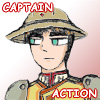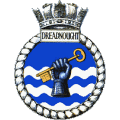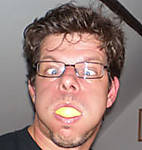Hi James, thanks!

My in-progress photos of these things are never quite as good as my final photos due to lighting etc., but I'm glad they turn out pretty well. While working on the Musashi, I used to cart out all the lights and such to take progress shots, but that often threw off my "building groove", so now I work with the same lights I build by, until the finals.

Update:
Remember how I hollowed out the bridge to put some crew in? That part of the build has now come into focus. Unfortunately, I forgot to take a picture of the interior after I put dull coat on the inside, so we only have this picture with everything kind of shiny-- before I closed up the bridge by gluing on the roof.

Anyway, this gives added interest when looking at the bridge up close because there are people inside.

And now for the moment of truth...

 WEATHERING THE DECK
WEATHERING THE DECK 

---------------------------
Disclaimer: I have weathered the deck a bit more than I usually do on my builds. I've never been a fan of unrealistic "over weathering" and my other builds will show this. However, I beefed up the weathering of the deck here mainly so that it wouldn't get lost under all the planes. As with bringing up the hull weathering so it would still catch the eye in the shadow of the deck, I now will do the same thing so the deck can be seen in the shadow of the planes.
The fact that the Hiryu was the IJN carrier that survived the longest at Midway also gives a little more opportunity to dirty her up (she was prepping a third strike when the Americans arrived and put her out of offensive action-- although her own planes had already stopped the Yorktown).
----------------------------
You'll remember how the deck has been gloss coated all this time. This was to set up the area so that washes could flow more easily. These washes are done with Vallejo Panzer Aces paints, generally a drop of paint thinned with water to the consistency I like, and a drop or two of dish soap added to aid in flow and prevent puddling. I have no hard and fast rule of how much water I add-- I just put in however much I need to get the tint/ transparency I want.
The contrast on the next four pictures is a little higher to better illustrate what I'm doing (it looks a little garish but you can see what I'm talking about).
First, a very thin coat of Old Wood is put on the give a basic grounding for the colors. Note that this color is placed on the entire surface, not just the wood.

Another, thicker, wash of Old Wood is applied to certain areas of the wood only to give the effect of different plank coloring. New Wood is also applied in the same manner.

Some Black is sparingly added in small pin washes to bring out highlights such as the arresting cable mounts (cables themselves to be added later). Black streaks are also added to depict tire traffic from the planes from landing, etc. Dark Rust is also added to give some added texture without being as overpowering as black.

Finally, Light Rust is applied. This is done in two different capacities: on metal areas to depict rust and wear; and in spots on the wood areas, where after blending with the previous colors, to depict stains and spilled liquids. This is the step that I dialed up some specifically to give the deck more of a boost under the planes. I would normally stop somewhere between the second and third steps. Note that the elevators get more washes applied per area-- this is because per capita on the ship, the elevators see more consistent use than anywhere else per square foot.

Switching views, we can now see the rest of the ship going down the length. Note the overall effect of the black streaks from planes taking off and landing. Also note how the area in front of the deflector is less weathered than aft. This is because most aircraft handling and operations take place behind the deflector (which is the whole point), so in front is less likely to get messy (I'm still unsure weather to put a plane at the Hinomaru as if some last minute checks had to be worked out). That decal screw up from earlier still worries me...
Unlike the previous pictures, the contrast on these is normal, so this is closer to what the deck actually looks like (more subdued).




Focusing in on the island, where direction finders and mast have been added. This has been weathered similar to the hull (Black, Dark Rust, Light Rust), albeit less so as 1.) it's farther from the water and protected by the deck and 2.) its view is clear and doesn't have to stand out from a "layer" of objects above.


More views of the weathering, including apron and deflector shots.



It's important to note that everything here is done with washes ONLY. After a dull coat is sprayed, some powders will be added, as will dry brush effects.
Here is what's left to do, working from inside out:
1. Finish planes
2. Dull coat deck and powders/ dry brush
3. Rigging/ flags
4. Mount planes and people
5. Mount/ weather/ rig antenna towers and side boat davits and boat
6. Final dullcoat
7. Glass
8. Finish water
Whew!

 Man, I need to build the Lexington now!
Man, I need to build the Lexington now! 



 Man, I need to build the Lexington now!
Man, I need to build the Lexington now! 











 That was always looming large, but thankfully it all worked out.
That was always looming large, but thankfully it all worked out. 



















 With any luck I should have another update soon.
With any luck I should have another update soon.
















 cheers
cheers 



 My in-progress photos of these things are never quite as good as my final photos due to lighting etc., but I'm glad they turn out pretty well. While working on the Musashi, I used to cart out all the lights and such to take progress shots, but that often threw off my "building groove", so now I work with the same lights I build by, until the finals.
My in-progress photos of these things are never quite as good as my final photos due to lighting etc., but I'm glad they turn out pretty well. While working on the Musashi, I used to cart out all the lights and such to take progress shots, but that often threw off my "building groove", so now I work with the same lights I build by, until the finals. 
 Anyway, this gives added interest when looking at the bridge up close because there are people inside.
Anyway, this gives added interest when looking at the bridge up close because there are people inside.
 WEATHERING THE DECK
WEATHERING THE DECK 












 Barry, I'll be collating this build log into a booklet to accompany the model at shows, so that people can see how this was built as well as calling out points of detail.
Barry, I'll be collating this build log into a booklet to accompany the model at shows, so that people can see how this was built as well as calling out points of detail. 
















 Also of note is the fact that there are 78 Hinomarus applied (six per plane on thirteen planes).
Also of note is the fact that there are 78 Hinomarus applied (six per plane on thirteen planes).

